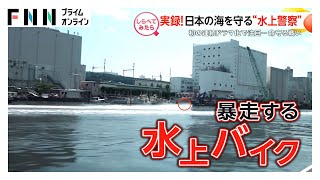TOKYO, Oct 20 (News On Japan) –
Tokyo’s seas and rivers, once considered lawless backwaters beyond the reach of regular policing, are now under constant watch by a dedicated force known as the “water police,” specialists who patrol the capital’s waterways, chase down smugglers, stop reckless jet ski riders, and carry out dramatic rescue missions to save lives.
[embedded content]
From pursuing boats dumping contraband into the sea to apprehending a 70-something couple caught smuggling drugs in a speed-modified vessel after a tense one-hour chase, water police units face a wide range of maritime crimes and emergencies that unfold daily on the water.
Operating out of the Tokyo Bay Coastal Police Station — the largest water policing unit in Japan — these officers combine investigative policing with specialized maritime skills. Their missions range from pursuing fleeing smugglers and enforcing fishing laws to patrolling for accidents and responding to disaster scenarios such as bridge collapses and floods. Patrol boats are equipped with emergency rescue systems like transom lifts, which lower into the water to hoist drowning victims onboard. Officers regularly train for life-saving operations and conduct joint drills with coast guard units, as water-related accidents often occur during sudden weather changes or when boats drift out of control.
In one incident, a rescue team saved an 85-year-old man whose boat had drifted two kilometers in strong winds and was about to sink. Even when victims refuse to abandon their vessels, officers must intervene quickly to prevent tragedy. However, their work is not always about dramatic rescues. Routine patrols also involve tracking down reckless jet ski riders who ignore maritime etiquette by speeding and generating dangerous waves in busy canals, often prompting noise complaints from nearby residents in high-rise buildings. Offenders are stopped and warned about proper navigation rules, and repeat incidents are closely monitored.
The water police also play a critical role during large public events. Patrol boats provide security during fireworks festivals on the Arakawa River, where tens of thousands gather and many watch from the water, a situation that has led to accidents in the past. Officers also participate in community outreach programs to warn against fraud and educate the public about water safety, with boat ride experiences drawing long queues.
Because of Tokyo’s extensive network of rivers and canals — including the Sumida and Tama rivers — and its status as a major international port with over 500 ships calling daily, the water police operate a fleet of 23 patrol vessels, the largest in Japan. They also perform regular water depth surveys to ensure safe navigation, especially in shallow areas like the Nihonbashi and Kanda rivers, where tides and construction projects such as the underground relocation of an expressway affect water levels. Detailed information on water depth and safe routes is shared with police units before operations to prevent accidents.
Emergency calls are handled 24 hours a day from five water police outposts across the city. In one dramatic nighttime incident, officers responded to a report of a person swept away near the Tama River. Despite shallow waters preventing their patrol boat from approaching closely, the crew, armed with prior survey data, guided the operation while the Kawasaki Fire Department’s water rescue team retrieved the victim, who was later confirmed dead.
Through dangerous pursuits, precision rescues, and continuous vigilance, Tokyo’s water police stand as an essential but often unseen force safeguarding the capital’s waterways. Their mission goes beyond law enforcement — they are the first responders when lives are at stake and the last line of defense against accidents, crime, and disorder on Japan’s busiest urban waters.
Source: FNN
Disclaimer : This story is auto aggregated by a computer programme and has not been created or edited by DOWNTHENEWS. Publisher: newsonjapan.com







